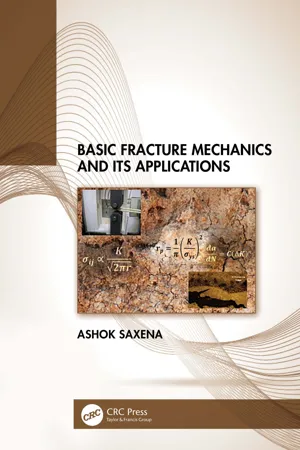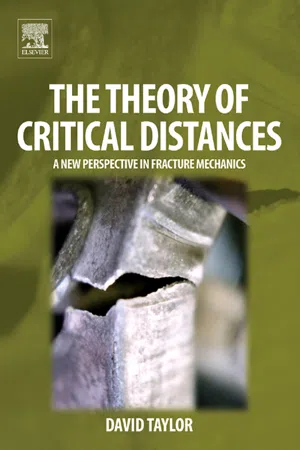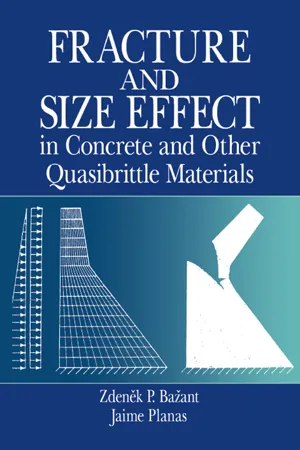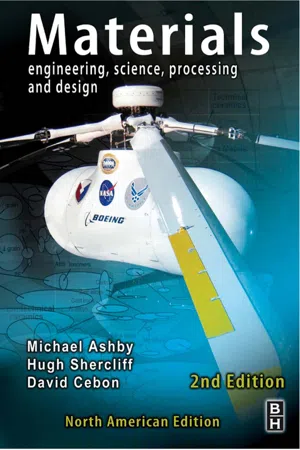Technology & Engineering
Fracture in Materials
Fracture in materials refers to the process of a material breaking or cracking under stress. It is a critical concern in engineering and design, as it can lead to structural failure and safety hazards. Understanding the mechanisms of fracture and implementing measures to prevent it are essential for ensuring the reliability and durability of materials and structures.
Written by Perlego with AI-assistance
Related key terms
Related key terms
1 of 4
Related key terms
1 of 3
8 Key excerpts on "Fracture in Materials"
- eBook - ePub
- Ashok Saxena(Author)
- 2022(Publication Date)
- CRC Press(Publisher)
1 Fracture in Structural ComponentsDOI: 10.1201/9781003292296-1The economic impact of fracture in engineering materials and components in the United States was once estimated at about 4.4% of its gross domestic product (GDP) [1 ]. By the size of the economy in 2021, this would be approximately one-trillion US dollars which is high even if one allows for uncertainties associated with such estimates. Thus, fracture in structural components must be prevented across industries such as ground, air, and sea transportation, chemical, power-generation, civil infrastructure, sports equipment, and biomedical prosthetics where stakes are high. The potential risk of fracture also cuts across all types of structural materials used in construction such as metals, ceramics, polymers, and composites. Consequently, fracture has been studied extensively since industrialization in the mid-nineteenth century and continues to be an important area of research in the twenty-first century, especially as new engineering materials evolve, and designs become more efficient. This chapter explores the significance of fracture and why it has been and continues to be an important engineering topic for academic and industrial research. The chapter also presents the early history of developments in understanding of fracture and recognizes the contributions of pioneers who led these developments.1.1 Fracture in Engineering Materials and Structures: Societal Relevance
1.1.1 Safety Assessments
Ensuring safety of people is one of the primary drivers of the need to prevent fractures in engineering structures. Fracture can lead to serious injuries and is threat to human life and are caused by failures in critical load-bearing components of automobiles, highways and bridges, trains, aircraft structures and engine components, pressure vessels used to store compressed combustible and non-combustible gases, and in host of other machinery and equipment used in our daily lives. Engineers are always aiming for fracture-safe design of components while designing them to be less bulky, using more economical materials, requiring less maintenance during service, and recyclable at the end of their design life. However, ensuring safety is paramount and any compromises cannot be justified by any of the above considerations. Thus, a thorough understanding of why components fail is an important aspect of safe designs. Quantifying risk of fracture is important in building adequate safety margins and redundancy in design of load-bearing components. - Yichun Zhou, Li Yang, Yongli Huang(Authors)
- 2013(Publication Date)
- CRC Press(Publisher)
2 Basis of Macro- and Microfracture Mechanics The “fracture” of materials or components is evident everywhere: in the production process and in life. For example, during the Wenchuan Earthquake in Sichuan, China, on May 12, 2008, uncountable houses collapsed instantaneously, and nearly 100,000 people lost their lives. In daily life, we see bridge collapses, train derailments, and air crashes, as well as minor and serious traffic accidents. There are too many examples to list. As college students and as researchers, what should we learn from these natural disasters and terrible accidents? Why are there so many destructive incidents? How can we prevent these destructive incidents from occurring? Why do materials or components become fractured? Are there identifiable patterns that characterize these destructive incidents, which seem to have no common features? This chapter will describe, from various destructive incidents, how to extract the fundamental theory, namely, the concept of “crack,” upon which the engineering and scientific problems of the fracture are analyzed. This chapter mainly describes the fundamental laws of macro- and microfracture mechanics from three aspects: macrofracture mechanics, microfracture mechanics, and nanofracture mechanics. 2.1 Analysis of Macrofracture Mechanics Because accidents happen we must ask: “why do materials or components become fractured?” From Chapter 1, we learned that materials and components do not exist in isolation but are applied with a certain load, which can result in deformation. When deformation or stress increases to a certain level, fracture occurs. This is the theoretical basis of the mechanics of materials- eBook - ePub
The Theory of Critical Distances
A New Perspective in Fracture Mechanics
- David Taylor(Author)
- 2010(Publication Date)
- Elsevier Science(Publisher)
Knott, 1973 ). Nevertheless, in this chapter we will briefly review the background material and introduce symbols and terminology, which will be used in the rest of the book. We will be concerned, in general, with the deformation and failure of materials under stress, but emphasis will be placed on those types of failure which will be the main subjects of the book, especially brittle fracture and fatigue, but also including ductile fracture and certain tribological failure modes such as fretting fatigue. Of special interest from a mechanics point of view will be cracks, notches and other combinations of geometry and loading, which give rise to stress concentrations and stress gradients. In this respect, the use of computer-based methods such as finite element analysis (FEA) will also be discussed. We will finish with critical appraisal of the use of traditional fracture mechanics and solid mechanics in failure prediction, setting the scene for the developments to be described in the rest of this book.1.1 Stress–Strain Curves
A fundamental way to obtain information about the mechanical properties of a material is to record its stress–strain curve, usually by applying a gradually increasing tensile strain to a specimen of constant cross section. Figure 1.2 shows, in schematic form, some typical results; note that here we are plotting the true stress (σ ) and true strain (ε), thus taking account of changes in specimen cross section and length during the test. Most materials display a region of linear, elastic behaviour at low strains, and in some cases (line 1) this continues all the way to failure. This is the behaviour of classic brittle materials such as glass and certain engineering ceramics. More commonly, some deviation from linearity occurs before final failure (line 2). This non-linearity has three different sources: (i) non-linear elasticity, which is common in polymers; (ii) plasticity, that is the creation of permanent deformation, which occurs principally in metals and; (iii) damage, which is important in ceramics and composite materials. We will define the stress at failure in all cases as the maximum point in the curve, and refer to it as σ u or the Ultimate Tensile Strength (UTS). In some cases (line 3) complete separation does not occur at σ u - eBook - ePub
Fracture Mechanics Of Electromagnetic Materials: Nonlinear Field Theory And Applications
Nonlinear Field Theory and Applications
- Xiaohong Chen, Yiu-Wing Mai(Authors)
- 2012(Publication Date)
- ICP(Publisher)
Chapter 1Fundamentals of Fracture Mechanics
Classic fracture mechanics is concerned with the study of the mechanical state of a deformable body containing a crack or cracks by application of analytical mechanics to calculate the driving force for crack propagation and experimental mechanics to characterize the resistance of materials to crack extension. A highly important question in the development of a fracture mechanics theory is whether there is any particular thermodynamic quantity of a cracked body that can be interpreted as the "driving force" for crack propagation.1.1 Historical Perspective
The establishment of fracture mechanics as an engineering discipline dates back to the early work of Griffith (1921), Orowan (1948) and Irwin (1948, 1956, 1957, 1958). In Griffith’s famous paper “The phenomena of rupture and flow in solids” (Griffith, 1921), which quantitatively relates the flaw size to the fracture stress, he proposed an energy balance approach for the fracture of brittle materials with the introduction of the surface energy term by realizing that the relatively low strength and the size dependence of strength were due to the presence of crack-like flaws in the materials.The Griffith energy balance leads to a critical condition for fracture of an ideal elastic-brittle material: (1.1)where A is the crack area, W is the work done on the cracked body by external forces, U is the strain energy stored in the system, and Γsis the surface energy.For a through-thickness crack with length 2a in an infinite plate under remote tensile stress σ (Fig. 1.1 ), Griffith (1921, 1924) used the solution of Inglis (1913) to show that the fracture stress, σ(1.2)f, is given bywhere for plane stress and for plane strain, E is Young’s modulus, v is Poisson’s ratio, and is the specific surface energy.Fig. 1.1. Griffith crack with length 2a under remote tensile stress a. - Zdenek P. Bazant, Jaime Planas, W.F. Chen(Authors)
- 2019(Publication Date)
- Routledge(Publisher)
1 Why Fracture Mechanics? Fracture mechanics is a failure theory that1. determines material failure by energy criteria, possibly in conjunction with strength (or yield) criteria, and2. considers failure to be propagating throughout the structure rather than simultaneous throughout the entire failure zone or surface.While fracture mechanics has already been generally accepted in failure analysis of metal structures, especially in aerospace, naval, and nuclear engineering, its advent in the field of concrete structures is new. Therefore, after briefly outlining the history of this discipline, we will attempt in this introductory chapter to spell out the reasons for adopting the fracture mechanics approach and will focus especially on the structural size effect - the main reason for introducing fracture mechanics into the design of concrete structures.1.1 Historical PerspectiveConcrete structures are, of course, full of cracks. Failure of concrete structures typically involves stable growth of large cracking zones and the formation of large fractures before the maximum load is reached. So why has not the design of concrete structures been based on fracture mechanics, a theory whose principles have been available since the 1950s? Have concrete engineers been guilty of ignorance?Not really. The forms of fracture mechanics that were available until recently were applicable only to homogeneous brittle materials, such as glass or to homogeneous typical structural metals. The question of applicability of these classical theories to concrete was explored long ago, beginning with Kaplan (1961) and others, but the answer was negative (e.g., Kesler, Naus and Lott 1972). Now, we understand that the reason for the negative answer was that the physical processes occurring in concrete fracture are very different from those taking place in the fracture of the aforementioned materials and, especially, that the material internal length scale for these fracture processes is much larger for concrete than for most materials. A form of fracture mechanics that can be applied to this kind of fracture has appeared only during the late 1970s and the 1980s.- eBook - ePub
Materials
Engineering, Science, Processing and Design
- Michael F. Ashby, Hugh Shercliff, David Cebon(Authors)
- 2009(Publication Date)
- Butterworth-Heinemann(Publisher)
Chapter 8 Fracture and fracture toughnessChapter contents- 8.1 Introduction and synopsis 166
- 8.2 Strength and toughness 166
- 8.3 The mechanics of fracture 167
- 8.4 Material property charts for toughness 174
- 8.5 Drilling down: the origins of toughness 176
- 8.6 Manipulating properties: the strength–toughness trade-off 180
- 8.7 Summary and conclusions 183
- 8.8 Further reading 183
- 8.9 Exercises 184
- 8.10 Exploring design with CES 185
- 8.11 Exploring the science with CES Elements 185
It is easy to set a value on the engineering science that enables success, that makes things happen, but much harder to value engineering science that prevents failure, that stops things happening. One of the great triumphs of recent engineering science has been the development from the 1960s onward of a rigorous mechanics of material fracture. We have no numbers for the money and lives it has saved by preventing failures; all we know is that, by any measure, it is enormous. This chapter is about the ways in which materials fail when loaded progressively, and design methods to ensure that fracture won’t happen unless you want it to.Ductile and brittle fracture. (Image of bolt courtesy of Boltscience; www.boltscience.com )8.1 Introduction and synopsis
It is easy to set a value on the engineering science that enables success, that makes things happen, but much harder to value engineering science that prevents failure, that stops things happening. One of the great triumphs of recent engineering science has been the development from the 1960s onward of a rigorous mechanics of material fracture. We have no numbers for the money and lives it has saved by preventing failures; all we know is that, by any measure, it is enormous. This chapter is about the ways in which materials fail when loaded progressively, and design methods to ensure that fracture won’t happen unless you want it to.Sometimes, of course, you do. Aircraft engines are attached to the wing by shear-bolts, designed to fail and shed the engine if it suddenly seizes. At a more familiar level, peel-top cans, seals on food containers and many other safety devices rely on controlled tearing or fracture. And processes like machining and cutting use a combination of plasticity and fracture. - eBook - ePub
- Hani M. Tawancy, Anwar Ul-Hamid, Nureddin M. Abbas(Authors)
- 2004(Publication Date)
- CRC Press(Publisher)
Chap. 8 . It suffices to mention here that on a microscopic scale, plastic deformation occurs by motion of a crystal defect called dislocation. Barriers to dislocation motion increase the external force required to cause plastic deformation. Among those barriers are grain boundaries. Increasing the grain boundary area per unit volume by reducing the grain size can thus be expected to increase the yield strength consistent with Eq. (6.11).When dislocations are held up against a grain boundary, a state of localized stress concentration is developed. In comparison with a coarse-grained material (smaller density of grain boundaries), dislocations in a fine-grained material can move smaller distances before they are held up against grain boundaries, as further explained in Chap. 8 . However, as shown later, a coarse-grained material develops a higher level of stress concentration at a grain boundary. In general, stress concentration is relieved by either plastic deformation in a neighboring grain or opening a crack at the grain boundary. Because plastic deformation can occur more readily in a coarse-grained material, cracks are more likely to propagate by a ductile mechanism. In contrast, for a fine-grained material where deformation is suppressed, cracks tend to propagate by a brittle mechanism.As explained in Chap. 8 , phase transformations occurring in a material can also have a significant effect on its fracture behavior. For example, when an alloy is disordered, fracture occurs by a ductile mechanism, However, if it becomes ordered, fracture may occur by a brittle mechanism. Precipitation of secondary phases can also the change the fracture behavior from ductile to brittle, e.g., precipitation of σ phase.6.11 Basic Principles of Fracture Mechanics
It is recalled from Chap. 4 that toughness of a material, a property combining both strength and ductility, is a measure of its resistance to fracture. Since toughness corresponds to the area under the uniaxial stress-strain diagram, its unit is energy per unit volume equivalent to force per unit length.Basically, fracture mechanics aims at developing means by which crack propagation can be described on a macroscopic scale in terms of some measurable quantities. From the definition of toughness given in Chap. 4 , it becomes evident that the resistance to crack propagation must be expressed in terms of a parameter having the unit of force per unit length, which is called the crack extension force G. Since force per unit length is equivalent to energy per unit area, they both have the same physical meaning. According to the Griffith theory of crack nucleation, surface energy per unit area or surface tension equivalent to force per unit area is essentially the energy required to form a crack in a perfectly brittle material. In contrast, G - eBook - ePub
Dental Biomaterials
Imaging, Testing and Modelling
- R V Curtis, T F Watson(Authors)
- 2014(Publication Date)
- Woodhead Publishing(Publisher)
10Fracture mechanics characterization of dental biomaterials
N.D. RUSE, The University of British Columbia, CanadaPublisher Summary
Fracture mechanics is a relatively young discipline, the foundations of which are regarded as having been laid by the pioneering work early in the 20th century. In general, the characterisation of brittle materials/interfaces should be based on fracture mechanics investigations. Flaws in brittle materials, unlike ductile materials, do not allow the blunting of a crack and the relaxation of concentrated stresses. Consequently, the fracture is initiated at the critical flaw and usually propagates catastrophically through the specimen. This chapter presents a succinct, but comprehensive, review of the application of fracture mechanics methodology in the characterisation of hard tooth tissues, dental materials and dentally related adhesive interfaces. It is hypothesised that the results of fracture crack propagation studies will provide better predictors for the in vivo performance of restorative materials and restored teeth. Fracture mechanics investigations could lead to the optimization of not only the structure of materials and interfaces but also of the design of restorations.10.1 Introduction
Every year, there are several hundreds of articles published in the peer-reviewed literature and many more hundreds of posters or oral presentations reporting results of mechanical tests on dental materials. It is therefore rather astonishing to realize the minimal correlation that exists between the available in vitro data on mechanical properties and the in vivo performance of dental materials. Moreover, the in vitro data on mechanical properties are poor predictors for the long-term in vivo
Index pages curate the most relevant extracts from our library of academic textbooks. They’ve been created using an in-house natural language model (NLM), each adding context and meaning to key research topics.
Explore more topic indexes
Explore more topic indexes
1 of 6
Explore more topic indexes
1 of 4







